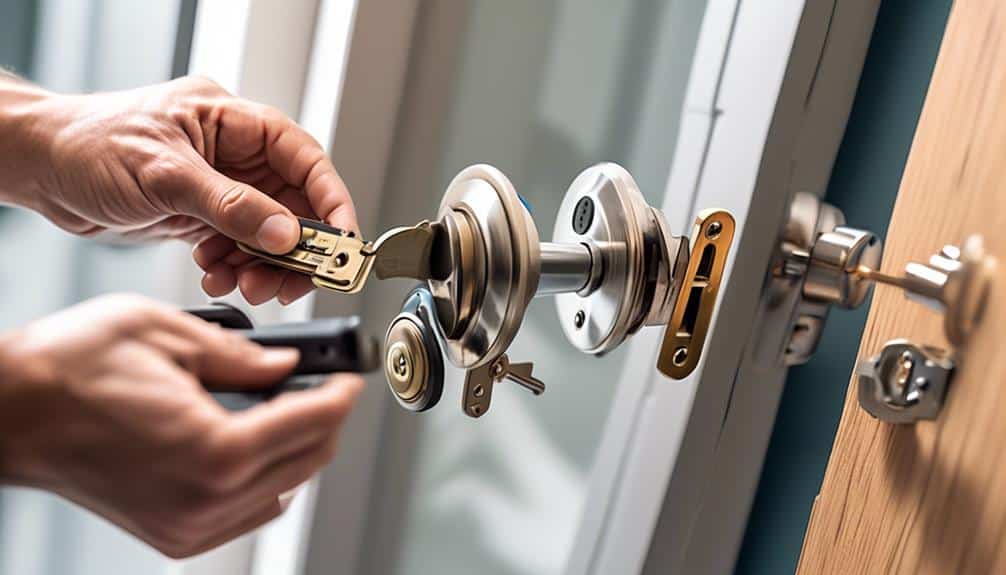When it comes to expert lock installation, there are a few pro tips that we, as professionals in the field, swear by.
From choosing the right lock type to ensuring proper alignment during installation, these tips can make all the difference in the security and functionality of your locks.
But what are these tips exactly? How can they help you achieve a flawless lock installation?
Well, in this discussion, we will dive into the details of each step, revealing insider knowledge that will leave you feeling confident in your ability to install locks like a pro.
Choosing the Right Lock Type
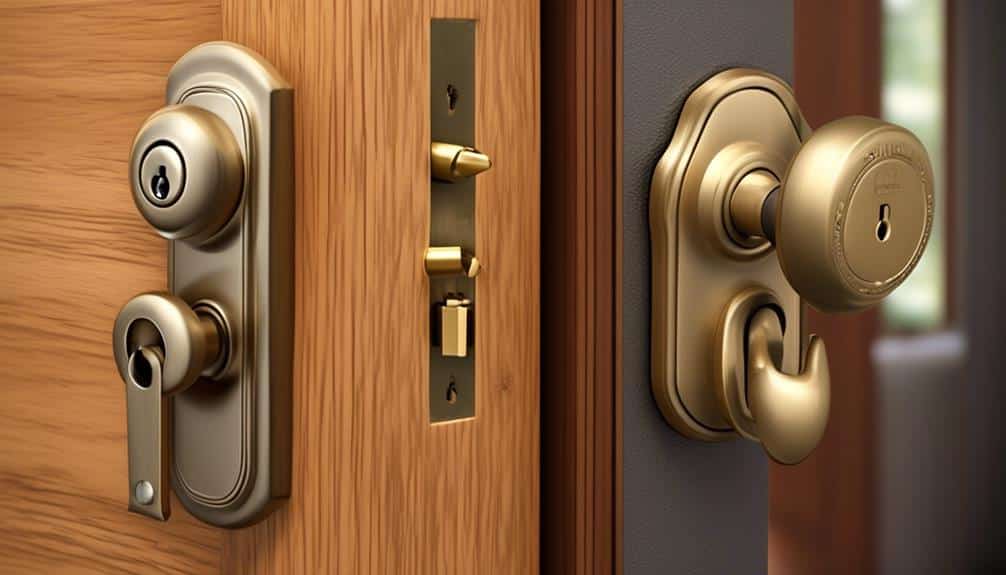
When selecting the appropriate lock for your needs, it's crucial to consider various factors such as security level, durability, and ease of use. Lock maintenance plays a vital role in ensuring the longevity and efficiency of your lock system. Regular maintenance helps to prevent common lock issues and keeps your locks functioning smoothly.
To maintain your lock properly, it's essential to clean it regularly. Dust, dirt, and debris can accumulate in the lock mechanism, leading to stiffness or jamming. A soft brush and compressed air can be used to remove any dirt particles.
Lubricating the lock is another critical aspect of lock maintenance. Applying a small amount of graphite powder or silicone-based lubricant to the keyway and moving parts of the lock can significantly improve its performance.
Despite regular maintenance, lock issues may still arise. Troubleshooting common lock issues can save you time and money. If your key isn't turning smoothly in the lock, applying a small amount of graphite powder can often resolve the problem. If your lock is sticking or difficult to turn, lubricating it may alleviate the issue. However, if these measures don't work, it's advised to contact a professional locksmith for further assistance.
Preparing the Door for Installation
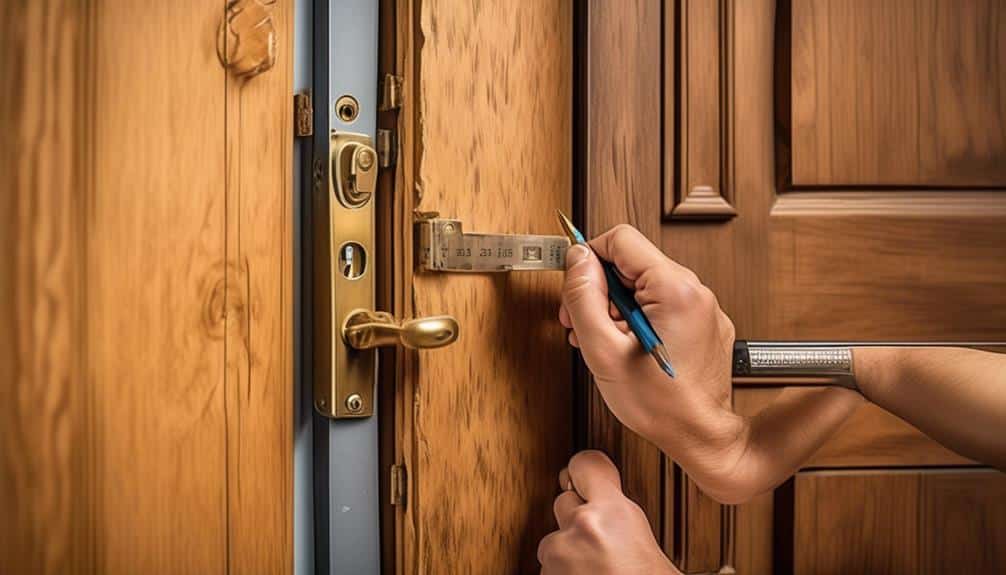
Before installing a new lock, there are a couple of important steps to take.
First, accurate door measurements must be taken to ensure that the new lock will fit properly. This includes measuring the thickness of the door and the diameter of the existing lock hole.
Once the measurements are taken, the next step is to remove the old lock from the door. This can be done by unscrewing the screws on the interior side of the door and pulling out the lock assembly.
Door Measurements
To ensure a precise and accurate installation, it's essential to carefully measure the dimensions of the door before proceeding with the lock installation process. Measuring accuracy is crucial to ensure that the lock fits perfectly and functions properly. Common measurement mistakes can lead to misaligned locks, which can compromise the security of the door.
When measuring the door, start by measuring the thickness, width, and height. Use a tape measure for accurate readings, and double-check the measurements to avoid any errors. Additionally, consider any existing hardware on the door, such as hinges or handles, as these may affect the lock installation.
Taking precise measurements will ensure a seamless installation and a secure lock for your door.
Removing Old Lock
Need to replace your old lock? Here's how to properly prepare the door for installation.
The first step is removing the hardware from the old lock. Start by unscrewing the screws that secure the lockset to the door. Once the screws are removed, carefully detach the lockset from the door, making sure not to damage the surrounding area.
Next, it's time to replace the cylinders. Locate the retaining screws on the cylinder and remove them using a screwdriver. Once the screws are out, gently pull the cylinder out of the lock body. Be cautious not to force anything, as this could cause damage.
With the old lock removed, you can now proceed to install the new lock.
Proper Measurement and Marking
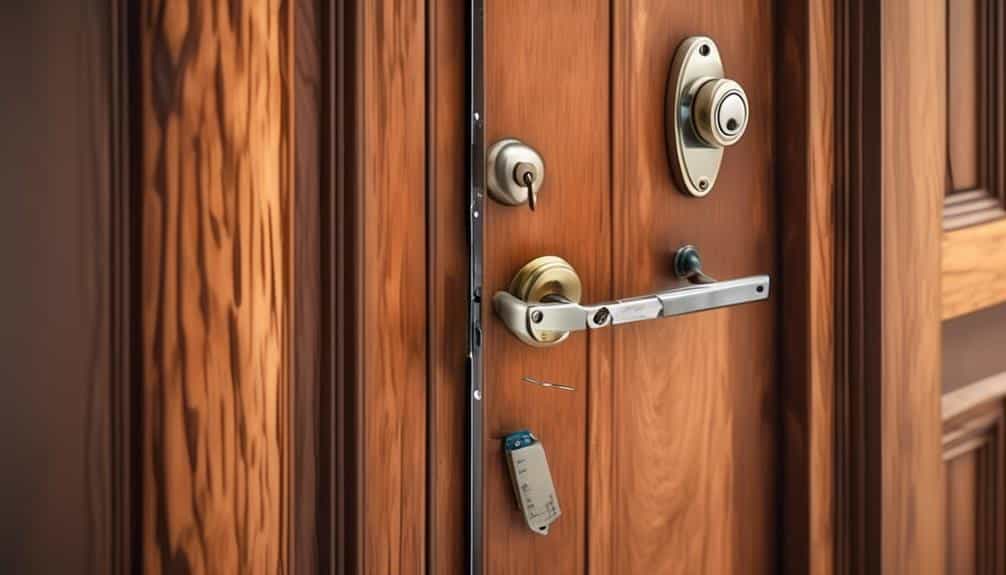
For optimal results, it's crucial to accurately measure and mark the necessary points prior to installing a lock. By employing proper measuring techniques and marking techniques, you can ensure a seamless installation process. Here are some pro tips to help you achieve precise measurements and markings:
- Use a reliable tape measure: Invest in a high-quality tape measure that provides accurate readings. Avoid using a ruler or yardstick, as they may not provide the level of precision required for lock installation.
- Measure multiple times: Double-check your measurements to eliminate any potential errors. Even the smallest miscalculation can lead to misalignment and difficulty in installing the lock.
- Mark with precision: Use a sharp pencil or a fine-tip marker to make clear and precise markings on the door or frame. This will serve as a guide during the installation process.
- Utilize templates or jigs: To ensure consistency and accuracy, consider using templates or jigs specifically designed for lock installation. These tools can help you mark the correct positions for holes and other key components.
Following these measuring and marking techniques will enable you to install the lock correctly the first time, saving you time and effort.
Selecting the Right Tools for the Job
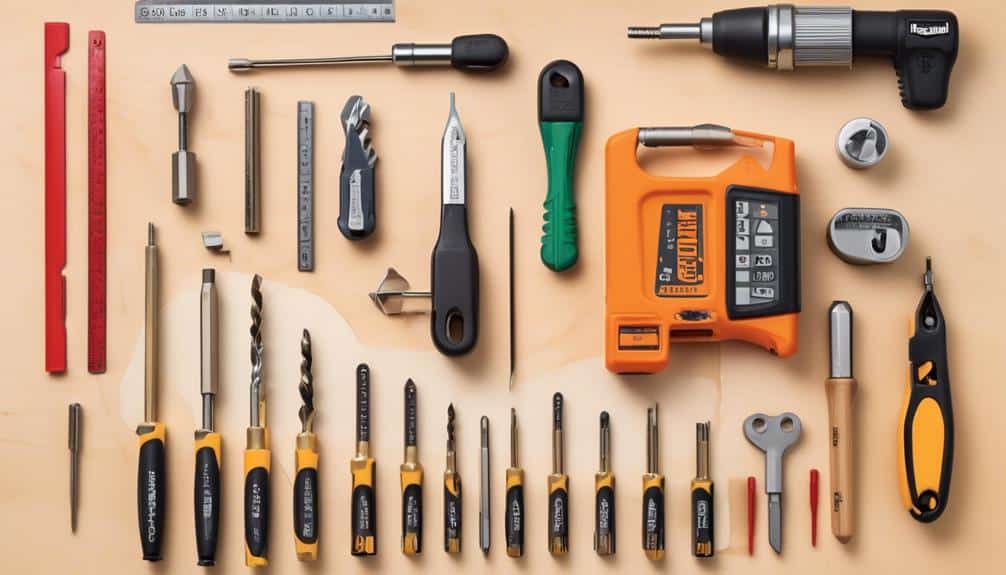
When it comes to lock installation, having the right tools is crucial. There are a few essential tools that every locksmith should have in their arsenal, such as a lock pick set, tension wrenches, and a plug spinner.
Key factors to consider when selecting tools include durability, versatility, and ease of use. For beginners, it's recommended to start with a basic tool set that includes the essentials and gradually expand their collection as they gain more experience and knowledge.
Essential Tools for Lock Installation
To ensure successful lock installation, it's crucial to carefully select the appropriate tools for the job. Having the right tools not only makes the task easier but also ensures that the installation is done correctly.
Here are some essential tools for lock installation:
- Drill: A high-quality drill with various drill bits is essential for drilling holes in the door for the lockset and latch.
- Chisel: A sharp chisel is needed to create clean and precise mortises for the lockset and strike plate.
- Screwdriver: A screwdriver is used for installing screws and adjusting the lock components.
- Tape Measure: Accurate measurements are crucial for proper lock installation, so a tape measure is a must-have tool.
- Level: A level helps ensure that the lockset and strike plate are correctly aligned.
- Pencil: Marking the location of the lockset and strike plate with a pencil helps with accuracy during installation.
Key Factors in Tool Selection
Selecting the appropriate tools for lock installation is a critical step in ensuring a successful and accurate installation. When it comes to key features and tool options, there are a few important factors to consider.
First and foremost, it's crucial to choose tools that are specifically designed for lock installation. These tools should have features such as adjustable tension, precision cutting edges, and durable construction.
Additionally, it's important to consider the type of lock being installed. Different locks may require different tools, such as specialized picks or tension wrenches.
Finally, it's essential to select tools that are comfortable and ergonomic, as lock installation can be a time-consuming process.
Best Tools for Beginners
Now let's explore the essential tools that beginners should consider when embarking on their lock installation journey. To ensure a successful installation without making common beginner's mistakes, it's crucial to have the right tools at hand. Here are two sub-lists of the best tools for beginners:
Lock Installation Tools:
- Screwdriver set: A set that includes various sizes and types of screwdrivers will be invaluable for removing and installing screws during the process.
- Drill with bits: A drill with different sized bits will allow you to create pilot holes and install locks securely.
- Measuring tape: Accurate measurements are essential for proper lock installation, so having a measuring tape is a must.
- Chisel: A chisel will help you to create recesses for the lock strike plate and latch plate, ensuring a clean and precise fit.
Troubleshooting Tools:
- Lock pick set: Having a lock pick set can be useful for troubleshooting and understanding the inner workings of locks.
- Lubricant: A lock lubricant can help if you encounter any sticking or jamming issues with locks.
Ensuring Proper Alignment During Installation
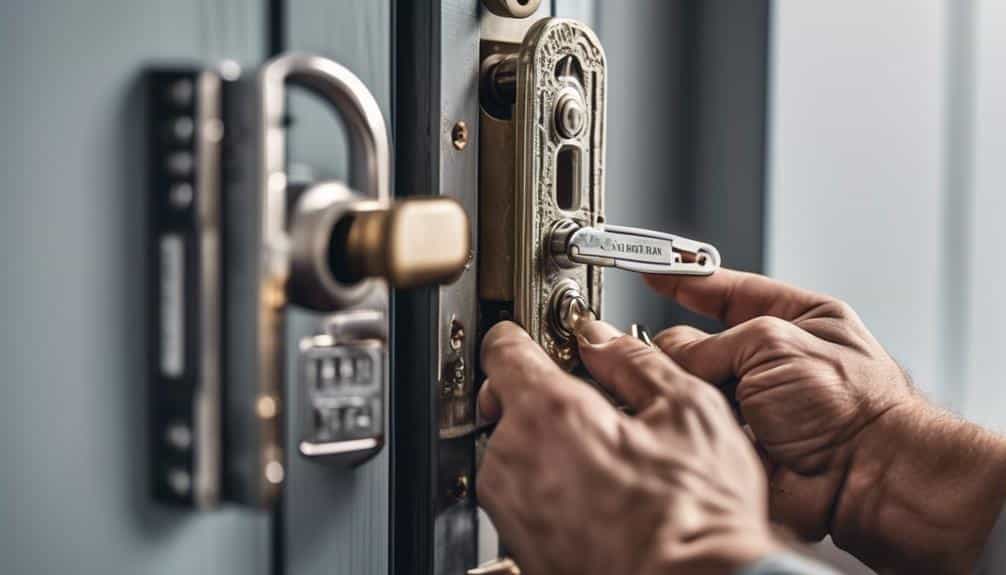
For proper alignment during lock installation, we must pay close attention to the positioning and orientation of the lock components. Ensuring proper alignment is crucial to the functionality and security of the lock. To achieve this, we need to check the door frame and troubleshoot common issues that may arise.
First, it's important to inspect the door frame to ensure it's in good condition. Check for any warping, cracks, or misalignment that could affect the proper installation of the lock. If any issues are found, they must be addressed and resolved before proceeding with the installation.
Next, the lock components must be positioned correctly. This includes aligning the strike plate with the door jamb and ensuring it's centered and flush with the door frame. The latch bolt should also be aligned with the strike plate and fit smoothly into it. Any misalignment can result in difficulty locking and unlocking the door.
Troubleshooting common issues during lock installation is essential to ensure proper alignment. If the strike plate or latch bolt doesn't align properly, adjustments may be needed. This can be done by loosening the screws and repositioning the components until they align correctly.
Securing the Lock Mechanism
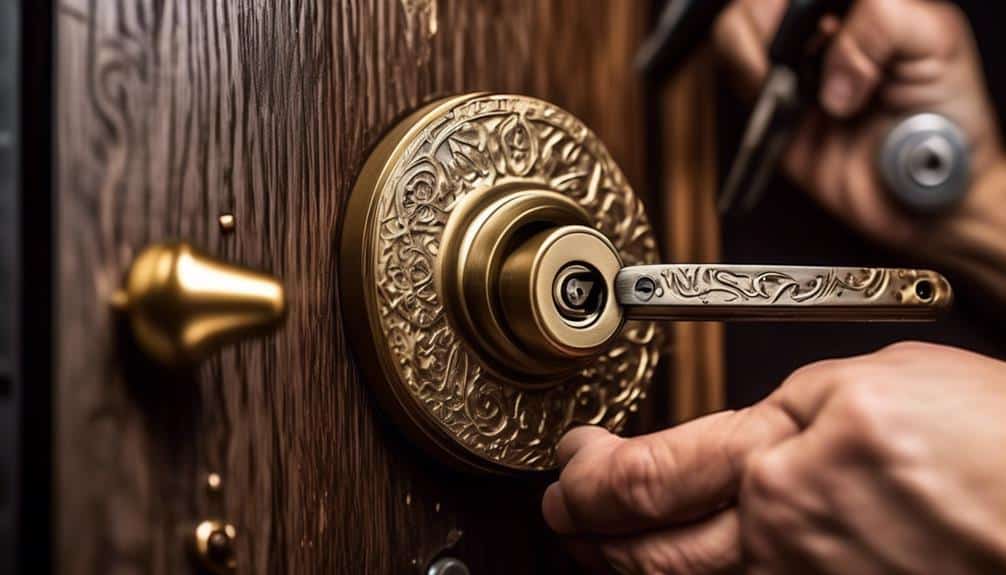
To secure the lock mechanism, it's crucial to properly fasten and tighten all screws and bolts to ensure a sturdy and reliable installation. Neglecting this step can lead to loose or wobbly locks, compromising the security of your property.
Here are some key considerations for securing the lock mechanism:
- Use the right tools: Ensure you have the correct screwdrivers and wrenches to securely fasten the screws and bolts. Using improper tools can damage the lock or result in inadequate tightening.
- Check for tightness: After installing the lock, go around and check the tightness of all screws and bolts. Use a screwdriver or wrench to tighten any that may be loose. This step is essential for preventing the lock from coming loose over time.
- Perform regular lock maintenance: Regularly inspect the lock mechanism for any signs of wear or damage. Lubricate the moving parts with a silicone-based lubricant to ensure smooth operation. This helps prevent common lock issues such as sticking or difficulty in turning the key.
- Troubleshoot common lock issues: Familiarize yourself with common lock problems and their solutions. For example, if the key is difficult to insert or turn, the lock may need cleaning or lubrication. If the lock cylinder is loose or wobbly, check the screws and bolts for tightness, and if necessary, tighten them.
Testing and Finishing Touches
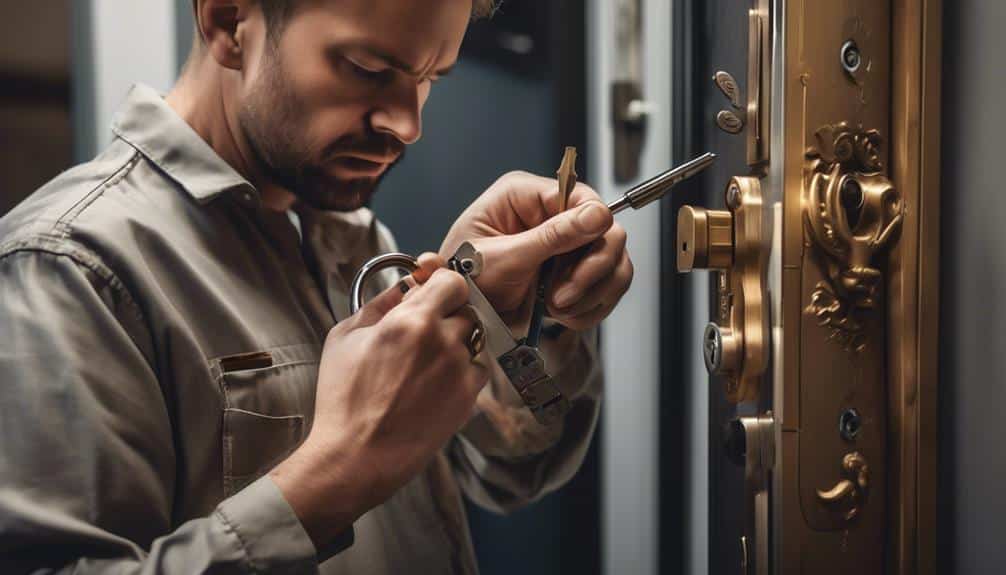
After securing the lock mechanism, the next step is to test its functionality and complete the finishing touches to ensure a smooth and professional installation. Proper testing techniques are crucial to ensure that the lock operates smoothly and securely.
To begin, test the key by inserting and turning it in the lock. Check for any resistance or difficulty in the turning motion. The key should glide smoothly without any hitches or jams. If you encounter any issues, troubleshoot by inspecting the lock mechanism for any obstructions or misalignments that may be causing the problem. Adjustments may need to be made to ensure proper alignment and operation.
Next, test the lock's latching mechanism. Close the door and engage the lock by turning the key or using the thumb turn. Ensure that the latch fully extends, securely locking the door in place. Test the door's stability by applying gentle pressure to it. It should remain firmly locked without any give or movement.
Additionally, test the lock's security features, such as deadbolts or electronic locking systems. Ensure that they function correctly and provide the desired level of security. Familiarize yourself with any additional features or settings the lock may have and test them thoroughly.
Frequently Asked Questions
Can I Install a Lock on a Hollow-Core Door?
Installing a lock on a hollow-core door can be challenging. It's important to follow best practices to ensure proper installation.
One interesting statistic to consider is that hollow-core doors are more susceptible to break-ins compared to solid doors.
To install a lock on a hollow-core door, make sure to reinforce the area around the lock with a strike plate. Additionally, consider using longer screws for added security.
Following these tips will help enhance the safety of your hollow-core door.
What Is the Recommended Height for Installing a Lock on a Front Door?
When it comes to installing a lock on a front door, the recommended height is typically around 36 to 42 inches from the bottom of the door. This ensures that the lock is easily accessible for both adults and children.
As for the best types of locks for front doors, deadbolt locks are highly recommended due to their strength and security features. It's important to choose a lock that meets your specific needs and provides the level of security you desire.
How Do I Know if My Door Frame Is Secure Enough for a Lock Installation?
To determine door frame strength and ensure proper lock alignment, there are a few key indicators to look for.
First, check for any visible damage or cracks in the frame.
Next, examine the hinges and make sure they're sturdy and properly attached.
Additionally, consider the material of the door frame; solid wood frames are typically stronger than hollow ones.
Lastly, test the frame by applying pressure to different points and seeing if it gives way.
Should I Consider Using a Smart Lock Instead of a Traditional Lock?
When deciding between a smart lock and a traditional lock, there are several factors to consider.
Smart locks offer convenience, allowing you to control and monitor your lock remotely. They also provide advanced security features such as keyless entry and activity logs.
However, they may be more expensive and require a stable internet connection.
Traditional locks, on the other hand, are reliable and affordable. They don't rely on technology and can be easily installed.
Ultimately, the choice depends on your specific needs and preferences.
Can I Install a Lock on a Sliding Glass Door?
Installing a lock on a sliding glass door has its pros and cons. On one hand, it adds an extra layer of security to prevent unauthorized access. On the other hand, it may require modifications to the door and frame, potentially compromising its structural integrity.
When choosing a lock, consider the type that suits your needs, such as a pin lock, key lock, or even a smart lock. Careful consideration and professional installation are essential to ensure both functionality and safety.

